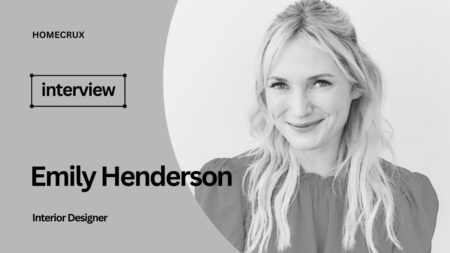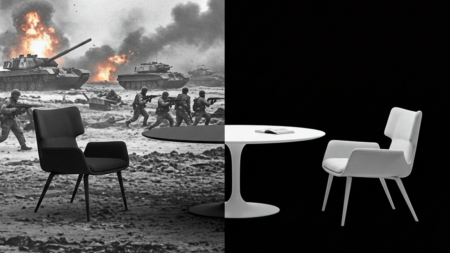Renowned Spanish designer and architect Ramon Esteve is a very busy man for he travels a lot for work and to experience different cultures and architectural styles to enrich his work. In 1991, Esteve founded his eponymous studio (Ramon Esteve Estudio) with the confidence that architecture is a globally expanding discipline. Since its inception, the studio has grown multiple folds expanding its works across architecture, interiors, industrial design, and graphic communication.
Despite his busy schedule, the Valencia-based architect managed to fit Homecrux for an exclusive conversation. In this chat with Homecrux, we ask Ramon about his design mantra, his thoughts on sustainability, and his never-ending love for sketching.
Homecrux (HC): Thanks for talking to us! Tell us about your experience in Milan this year. Any favorites from your exhibited work at Salone del Mobile?
Ramón Esteve (RE): This year in Milan, particularly at Salone del Mobile, was an exhilarating experience. The energy, creativity, and innovation present at the event were truly inspiring. Milan always has this unique ability to gather the best of the design world in one place, fostering an environment where ideas can flourish and collaboration is inevitable.
Of all the projects I’ve seen this year, there are many innovative exhibitions that have really stood out to me. Overall, Salone del Mobile continues to be a crucial event for showcasing innovation and excellence in design, and this year’s experience has only reinforced my passion for creating spaces and objects that resonate on a deeper, more emotional level.

HC: A lot of your collections are inspired by your country house. Tell us the story behind that. What makes your designs different from others? What is your favorite work so far?
RE: The country house is situated in a privileged natural environment, surrounded by vineyards with a spectacular view of the landscape. The design of Cottage in the Vineyard was driven by a desire to create a space that blends seamlessly with its surroundings, offering a sense of tranquility and connection to nature.
What sets my designs apart is this very focus on harmonizing with the environment and creating spaces that evoke a sense of peace and well-being. I strive to integrate natural materials, light, and the surrounding landscape into my work, ensuring that each project resonates with its context and the people who experience it. This approach leads to designs that are not only aesthetically pleasing but also deeply functional and emotionally engaging.
As for my favourite work so far, it is challenging to choose just one, as each project holds its own significance. However, Cottage in the Vineyard remains particularly close to my heart. It has been constant source of inspiration for many of my collections. It embodies my design philosophy and has influenced many subsequent works.

HC: What intrigued your interest in architecture and design? Who were the people in the industry you looked up to?
RE: My interest in architecture and design was sparked at a young age. Growing up, I was always fascinated by how spaces could influence our emotions and behaviours. The ability to shape environments that people inhabit and interact with daily intrigued me profoundly. I realized that architecture and design were not just about creating buildings or objects but about crafting experiences and enhancing the quality of life.
Several figures in the industry have significantly influenced my journey. Le Corbusier’s innovative use of space and form, Mies van der Rohe’s emphasis on simplicity and clarity, and Frank Lloyd Wright’s integration of structures with their natural surroundings were all deeply inspiring to me. Their work taught me the importance of combining functionality with aesthetics and how architecture can harmonize with its environment.
HC: It was in 1991 that you laid the foundation of Ramón Esteve Studio. How has the industry in general and you, in particular, changed in the last three decades?
RE: Founding Ramón Esteve Studio in 1991 marked the beginning of an incredible journey. Over the past three decades, both the industry and my own approach to design have undergone significant transformations.
The industry has seen a dramatic shift towards sustainability and environmental consciousness. There is now a greater emphasis on using eco-friendly materials and sustainable construction practices, which has become a core consideration in all my projects. Technological advancements have also revolutionized the way we design and build, from 3D modeling and virtual reality to smart home technologies and innovative building materials.
In my own practice, I have continually evolved by embracing these changes and integrating them into my work. Initially, my focus was primarily on residential architecture, but over the years, my portfolio has expanded to include public buildings, commercial spaces, and product design. This diversification has allowed me to explore new creative avenues and to collaborate with a wide range of clients and industries.
Looking back, the past three decades have been a period of continuous learning and adaptation. The industry will undoubtedly continue to evolve, and I look forward to embracing new challenges and opportunities in the years to come.

HC: You are one of the most influential designers today. How do you cope with the success and related performance anxiety?
RE: Thank you for your kind words. Coping with success and the associated performance anxiety is indeed a challenge, but it’s also a natural part of the journey for any designer. For me, there are a few key strategies that help maintain balance and perspective.
Firstly, I always return to my core passion for design. Remembering why I started and the joy that creating brings me helps to alleviate the pressure. It’s important to stay grounded in the love for the craft rather than getting too caught up in external expectations.
Secondly, I prioritize collaboration and teamwork. Surrounding myself with a talented and supportive team allows for a shared vision and collective problem-solving. This not only eases the burden but also enriches the creative process, as different perspectives can lead to innovative solutions.
Another crucial aspect is taking time to disconnect and find inspiration outside of work. Whether it’s spending time in nature, traveling, or simply enjoying moments with family and friends, these experiences recharge my creative energy and provide a fresh outlook.
Lastly, I believe in continuous learning and embracing challenges as opportunities for growth. Each project is a chance to push boundaries and explore new ideas, which keeps the work exciting and dynamic.
Balancing success with well-being is an ongoing process, but by staying true to my values and nurturing a supportive environment, I find it easier to manage the pressures and continue to produce meaningful and impactful designs.
HC: Sustainability and design should go hand in hand. What are your thought on the new design trend?
RE: Sustainability and design absolutely should go hand in hand, and it’s encouraging to see the growing trend towards more eco-conscious practices in the design world. This shift is not only necessary but also inspiring, as it challenges us to innovate and think creatively about how we use materials, energy, and space.
In my view, sustainable design is about more than just choosing eco-friendly materials. It’s about creating long-lasting, timeless pieces that endure both aesthetically and functionally. It involves considering the entire lifecycle of a product or building, from sourcing and production to usage and eventual disposal or repurposing.
One of the most exciting aspects of this trend is the increasing emphasis on local craftsmanship and materials. By supporting local economies and reducing transportation emissions, we can create designs that are not only sustainable but also deeply connected to their origins and communities.
Another key aspect is the integration of technology to improve energy efficiency and reduce waste. Smart systems, renewable energy sources, and innovative construction methods are all playing a significant role in making design more sustainable.
HC: Despite digital renders ruling the roost, you prefer sketching your designs. Has the habit changed or you still stick to the basics?
RE: I still hold a deep appreciation for sketching my designs by hand. There is something incredibly intuitive and personal about sketching that digital tools cannot fully replicate. When I sketch, I feel a direct connection between my ideas and the paper, which allows for a more organic and fluid exploration of concepts.
That said, I also recognize the value and capabilities of digital tools. They offer precision, the ability to quickly iterate on ideas, and the means to visualize designs in ways that sketches cannot. In my practice, I integrate both approaches. I start with sketches to capture the essence and initial vision of a project, and then use digital renders to refine and develop those ideas further.
This combination allows me to maintain the creative freedom and expressiveness of sketching while leveraging the technical advantages of digital design. So, while the habit of sketching has not changed, it has evolved to coexist with modern tools, enhancing the overall design process.


HC: What does Ramón Esteve do when he is not working on his next idea?
RE: I enjoy spending time in nature, particularly at Cottage in the Vineyard. It’s a place where I can relax, reflect, and find inspiration. I also love traveling, as it allows me to experience different cultures and architectural styles, which in turn enrich my own work. Reading and music are also important to me, as they provide a different kind of creative stimulation and help me unwind.
HC: Any suggestion for budding designers toiling to make the big stage?
RE: For budding designers aspiring to make it to the big stage, my advice would be to stay curious and never stop learning. Design is a field that constantly evolves, and it’s essential to keep up with new trends, technologies, and materials. At the same time, don’t be afraid to experiment and push boundaries. Authenticity and a unique voice are what make a designer stand out.
Networking is also crucial. Build relationships with other professionals in the industry, attend events, and engage with the design community. Lastly, be persistent. Success doesn’t happen overnight, and it’s important to stay dedicated and passionate about your work, even in the face of challenges. Every experience, whether a success or a failure, contributes to your growth as a designer.
We thank Ramón Esteve for taking out time to have this enriching conversation with Homecrux!
Follow Homecrux on Google News!




